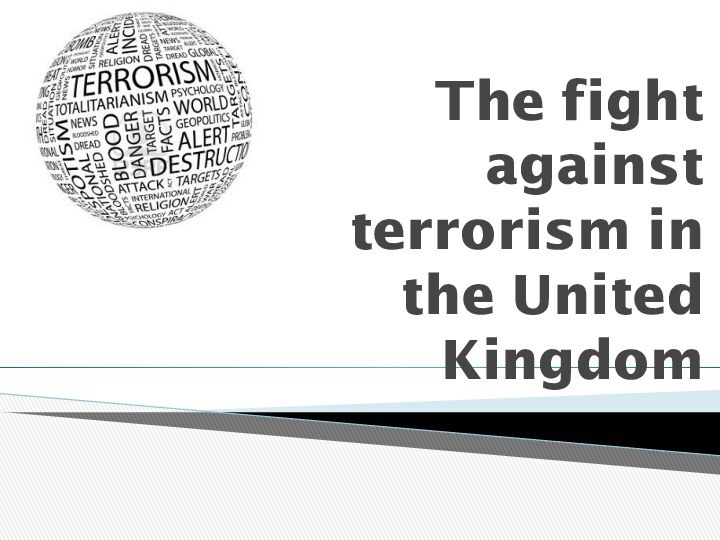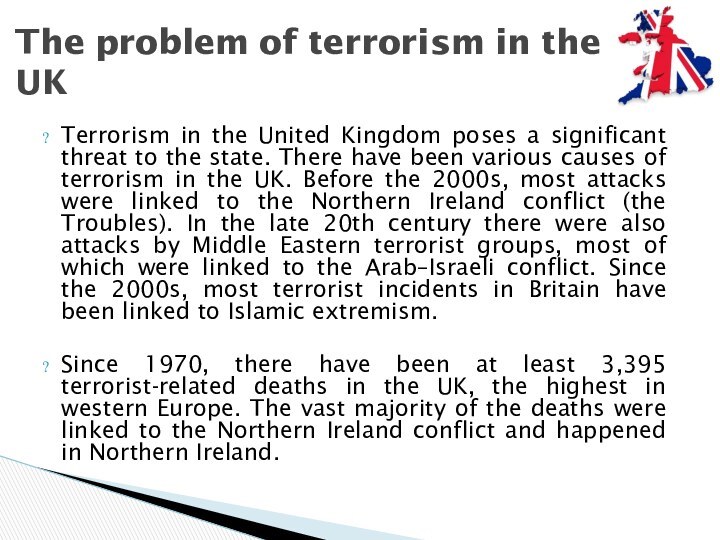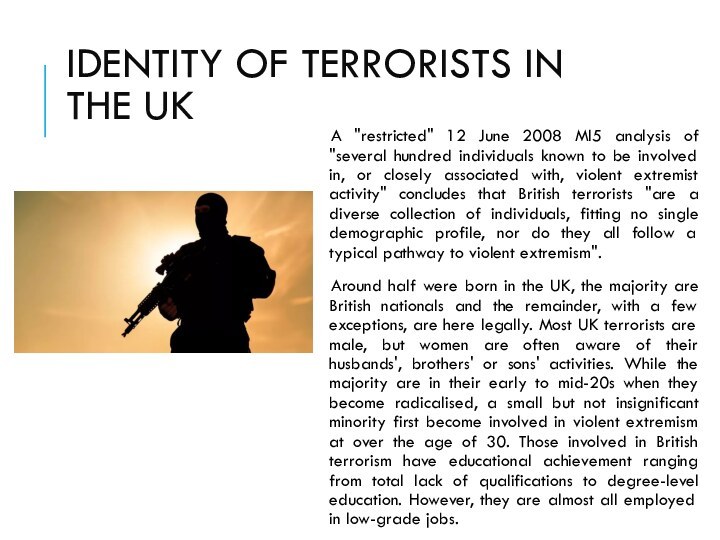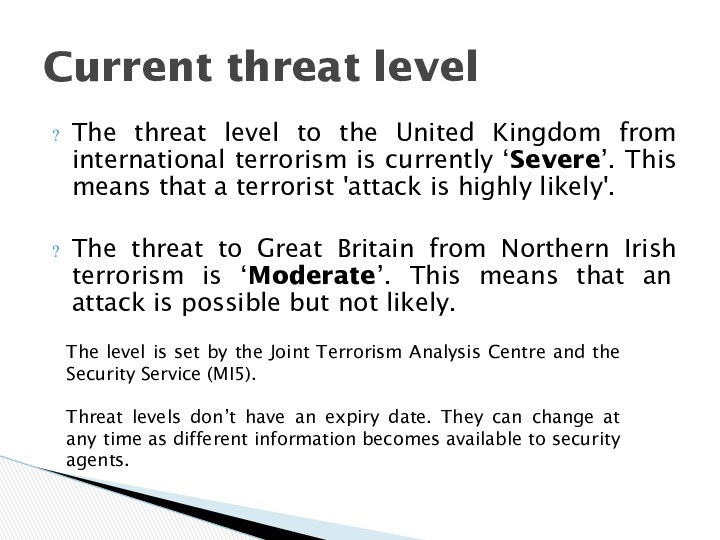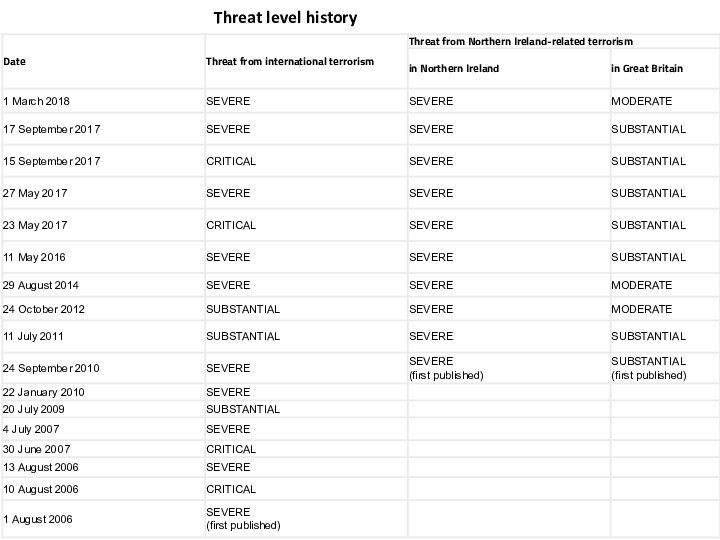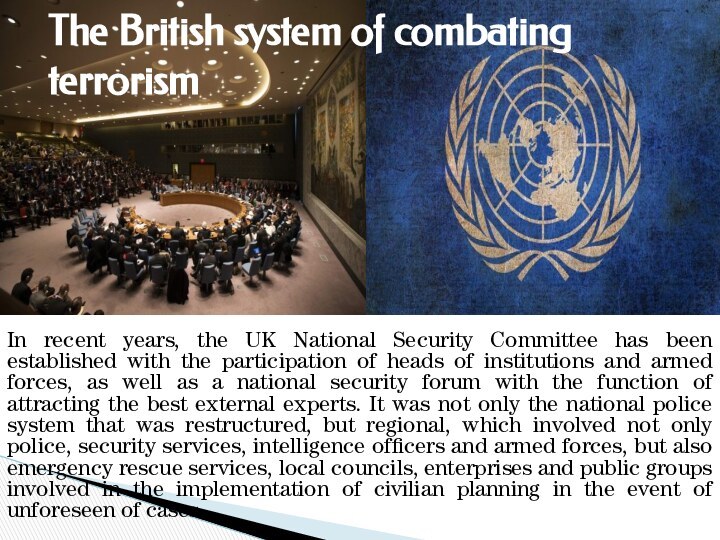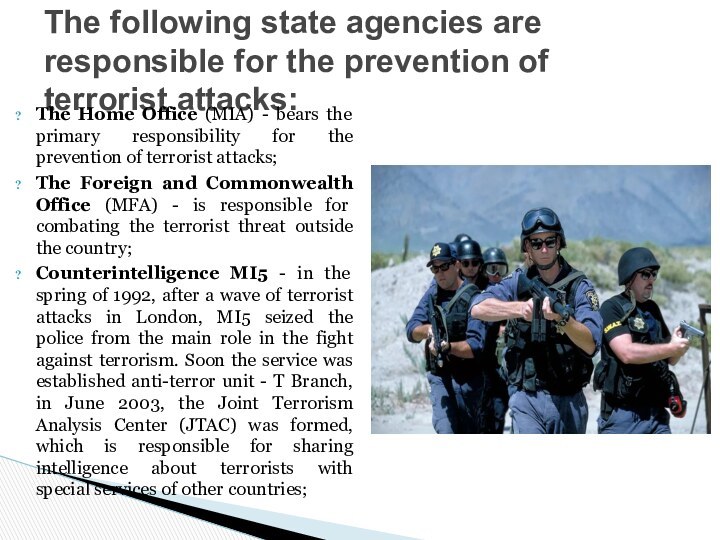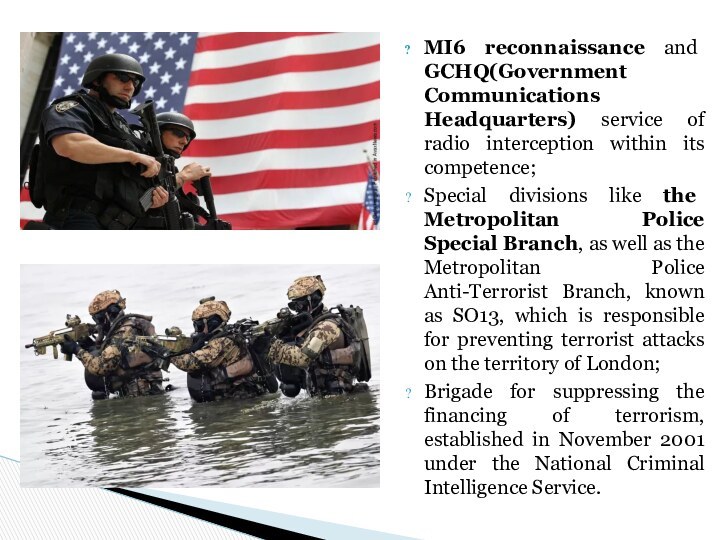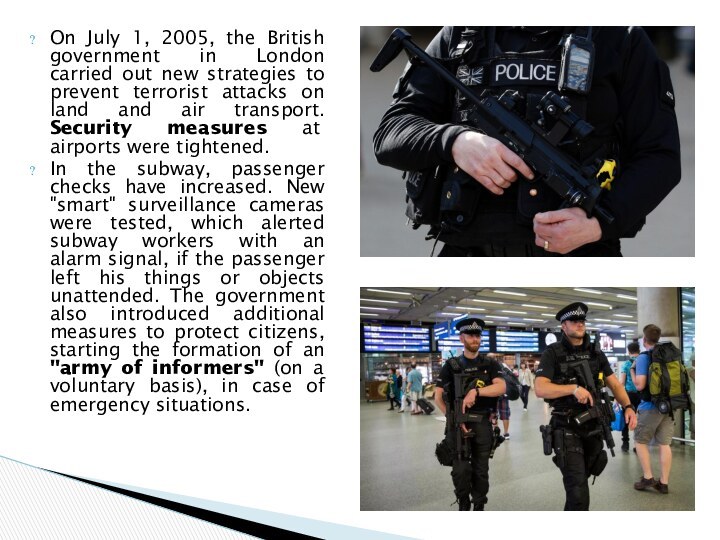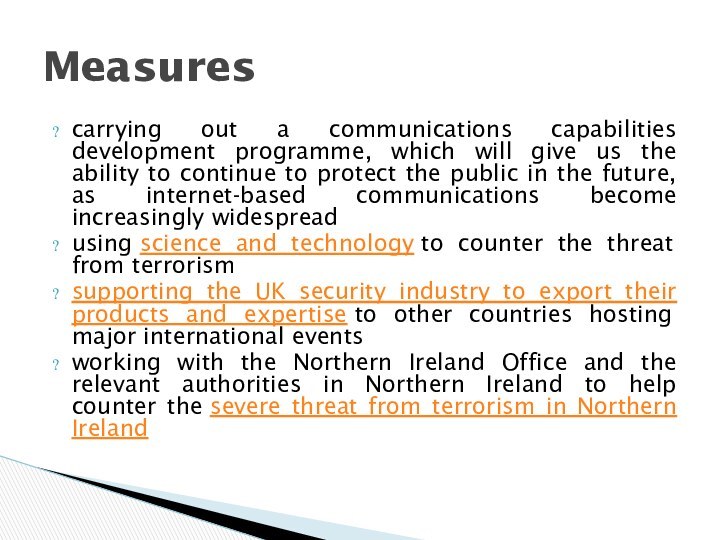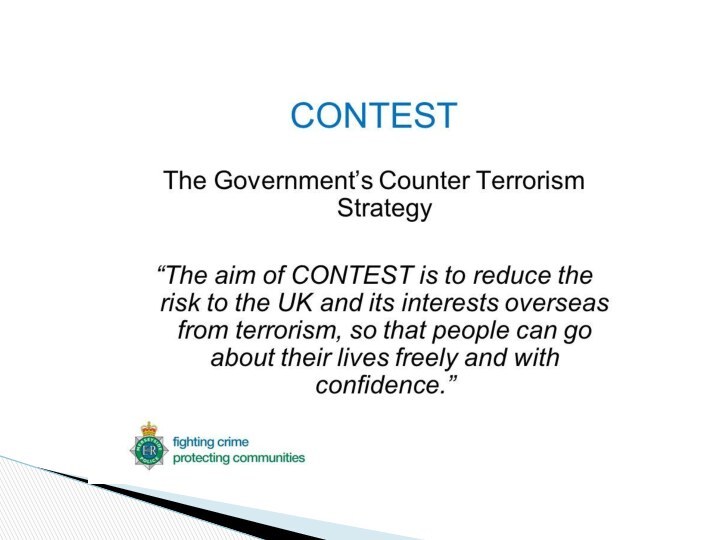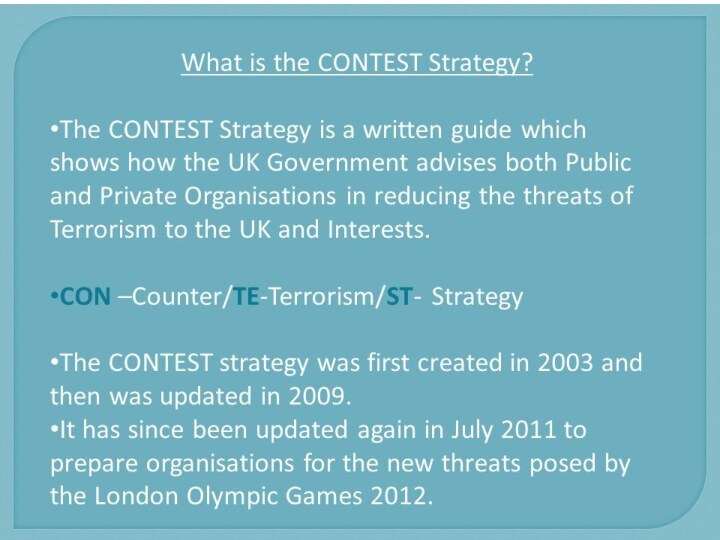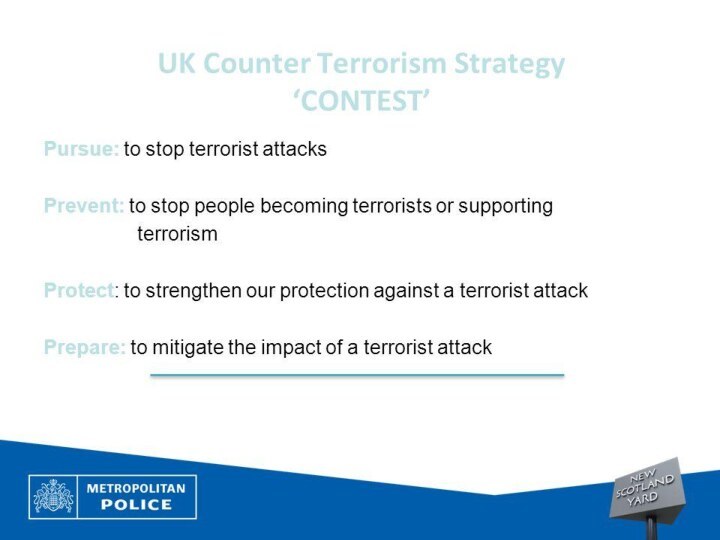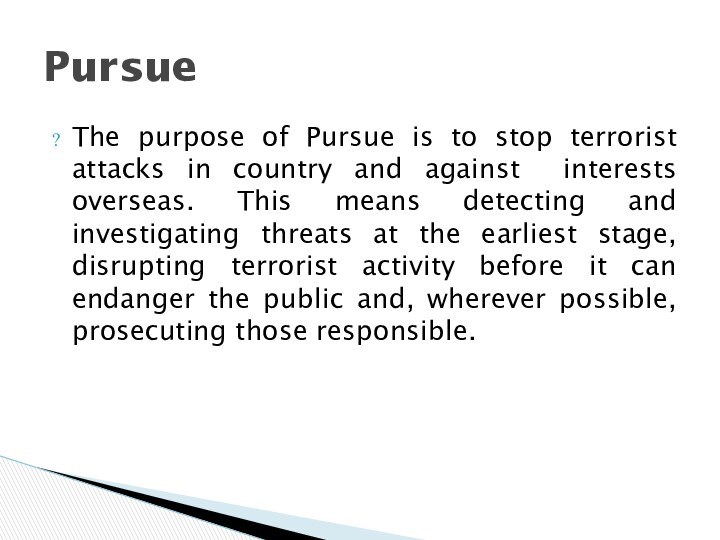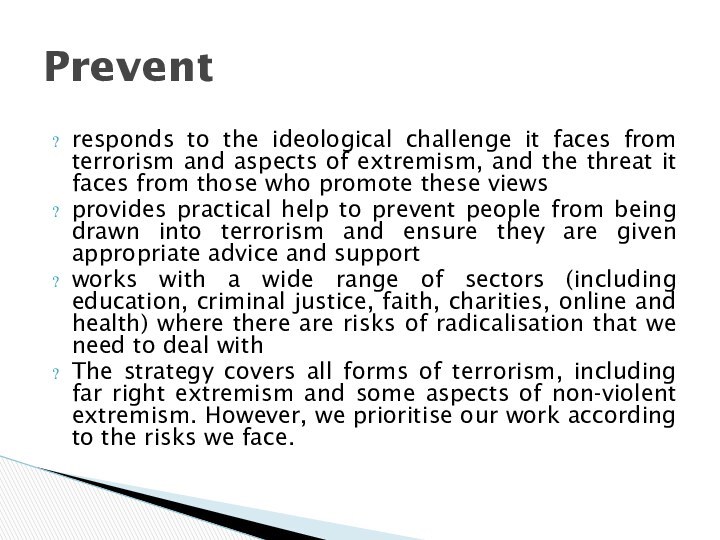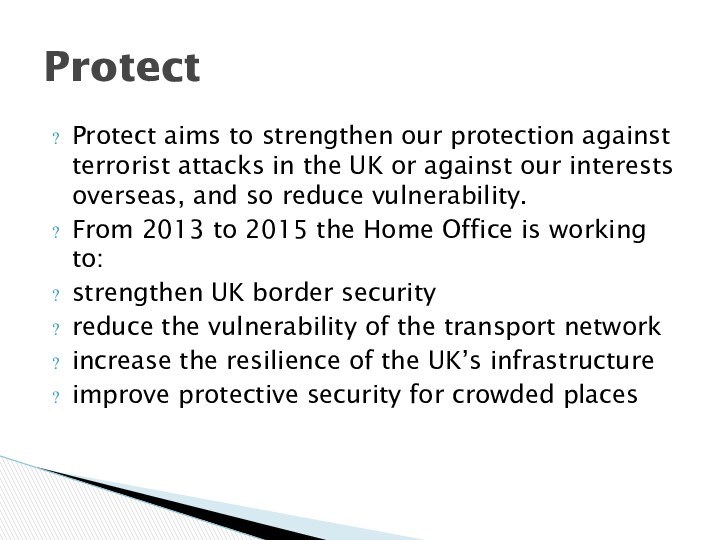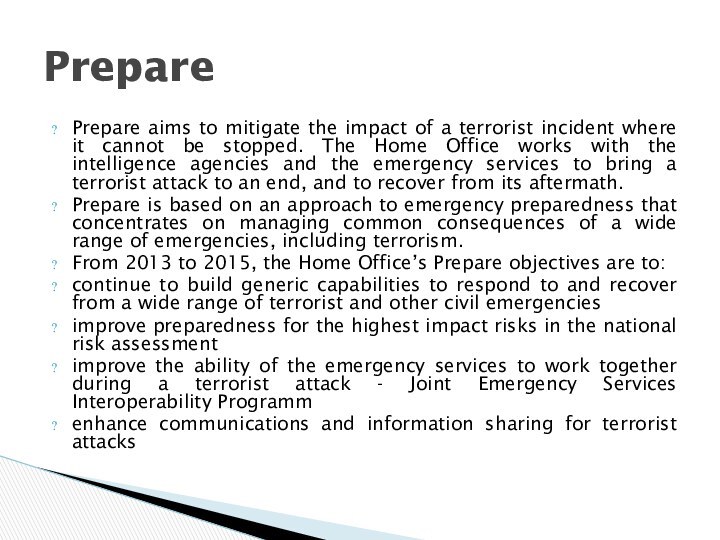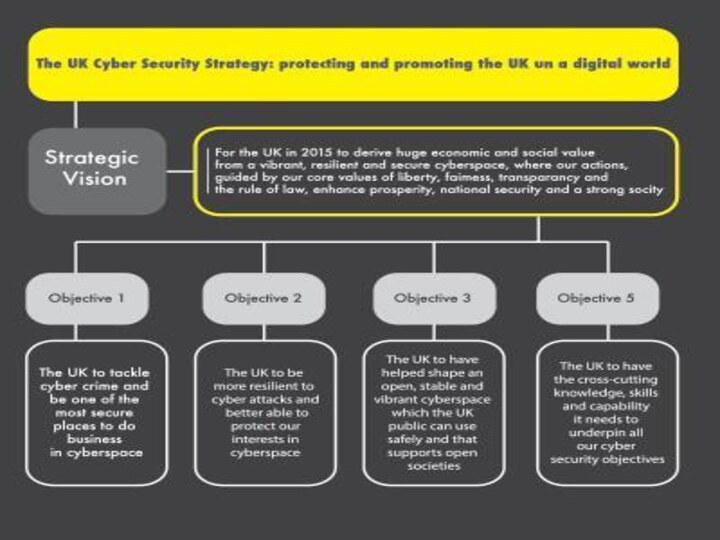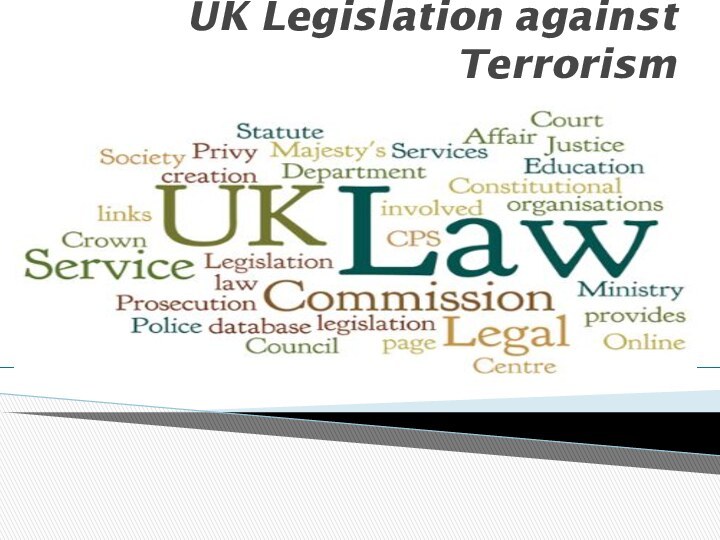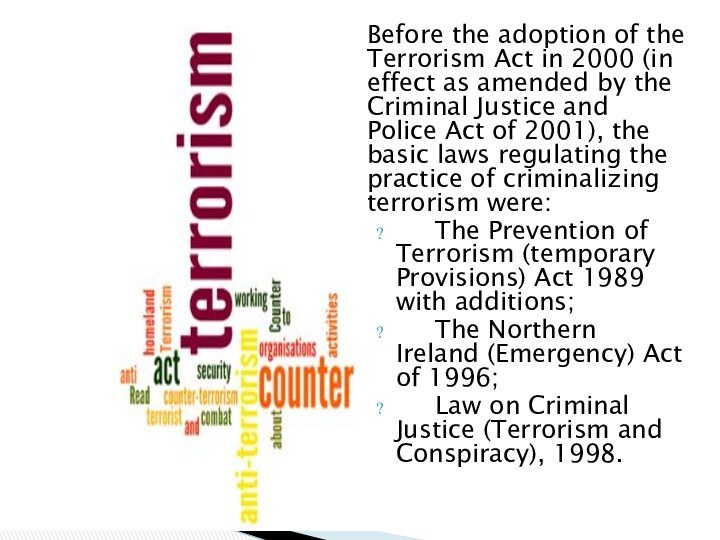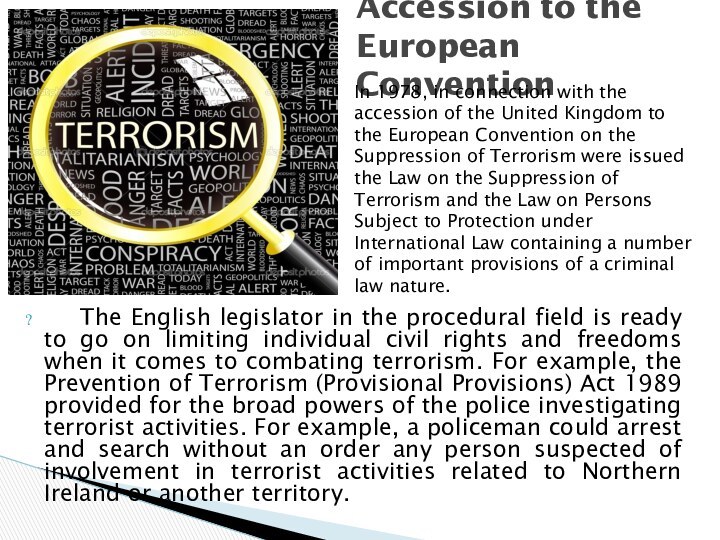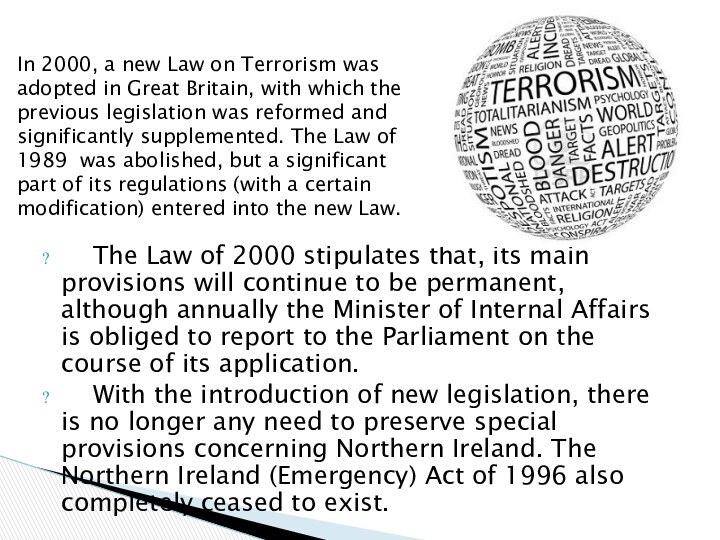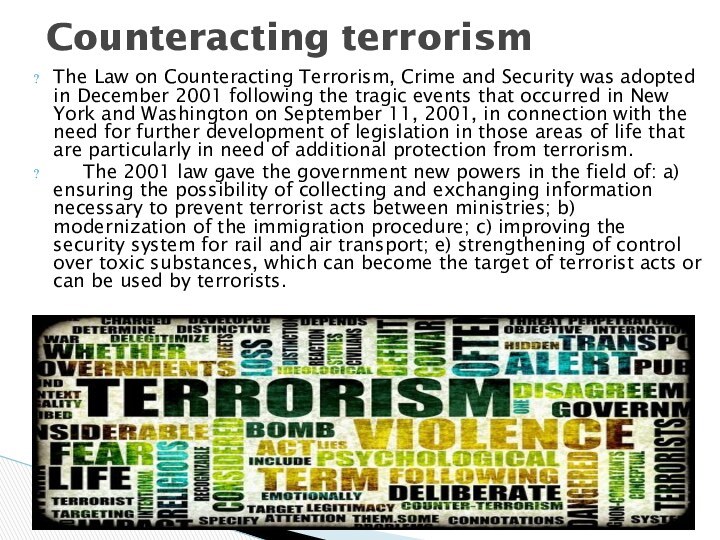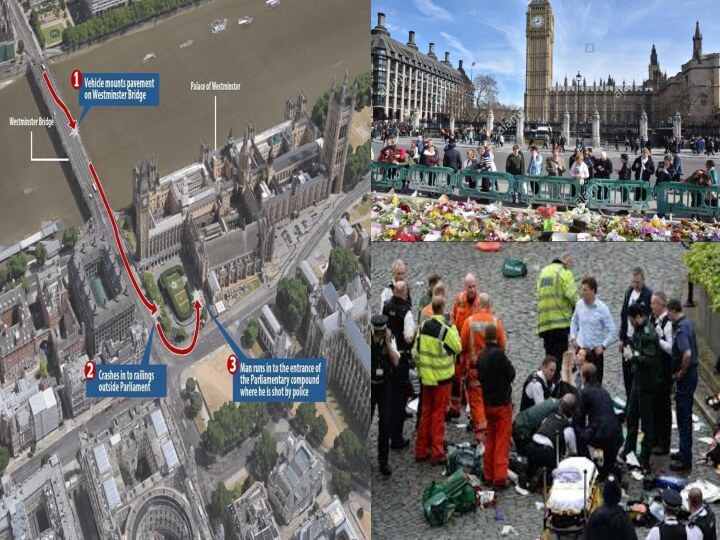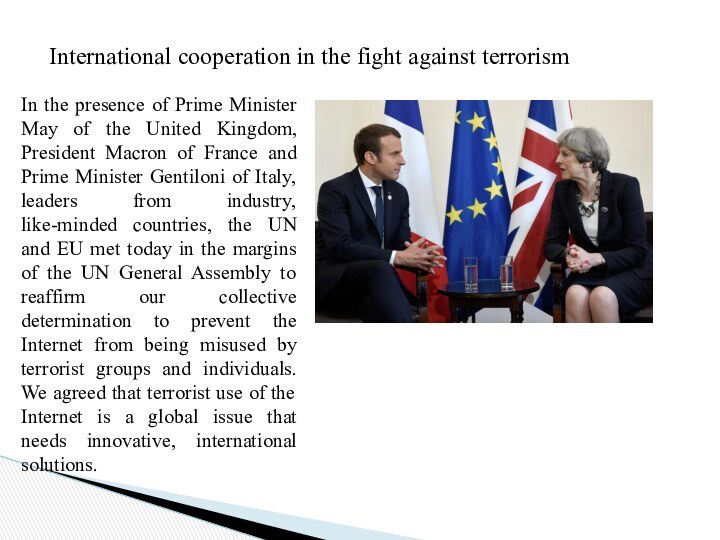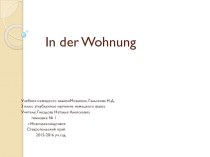Слайд 2
Terrorism in the United Kingdom poses a significant
threat to the state. There have been various causes
of terrorism in the UK. Before the 2000s, most attacks were linked to the Northern Ireland conflict (the Troubles). In the late 20th century there were also attacks by Middle Eastern terrorist groups, most of which were linked to the Arab–Israeli conflict. Since the 2000s, most terrorist incidents in Britain have been linked to Islamic extremism.
Since 1970, there have been at least 3,395 terrorist-related deaths in the UK, the highest in western Europe. The vast majority of the deaths were linked to the Northern Ireland conflict and happened in Northern Ireland.
The problem of terrorism in the UK
Слайд 3
IDENTITY OF TERRORISTS IN THE UK
A "restricted" 12
June 2008 MI5 analysis of "several hundred individuals known
to be involved in, or closely associated with, violent extremist activity" concludes that British terrorists "are a diverse collection of individuals, fitting no single demographic profile, nor do they all follow a typical pathway to violent extremism".
Around half were born in the UK, the majority are British nationals and the remainder, with a few exceptions, are here legally. Most UK terrorists are male, but women are often aware of their husbands', brothers' or sons' activities. While the majority are in their early to mid-20s when they become radicalised, a small but not insignificant minority first become involved in violent extremism at over the age of 30. Those involved in British terrorism have educational achievement ranging from total lack of qualifications to degree-level education. However, they are almost all employed in low-grade jobs.
Слайд 4
The threat level to the United Kingdom from
international terrorism is currently ‘Severe’. This means that a
terrorist 'attack is highly likely'.
The threat to Great Britain from Northern Irish terrorism is ‘Moderate’. This means that an attack is possible but not likely.
Current threat level
The level is set by the Joint Terrorism Analysis Centre and the Security Service (MI5).
Threat levels don’t have an expiry date. They can change at any time as different information becomes available to security agents.
Слайд 6
The British system of combating terrorism
In recent years,
the UK National Security Committee has been established with
the participation of heads of institutions and armed forces, as well as a national security forum with the function of attracting the best external experts. It was not only the national police system that was restructured, but regional, which involved not only police, security services, intelligence officers and armed forces, but also emergency rescue services, local councils, enterprises and public groups involved in the implementation of civilian planning in the event of unforeseen of cases.
Слайд 7
The following state agencies are responsible for the
prevention of terrorist attacks:
The Home Office (MIA) - bears
the primary responsibility for the prevention of terrorist attacks;
The Foreign and Commonwealth Office (MFA) - is responsible for combating the terrorist threat outside the country;
Counterintelligence MI5 - in the spring of 1992, after a wave of terrorist attacks in London, MI5 seized the police from the main role in the fight against terrorism. Soon the service was established anti-terror unit - T Branch, in June 2003, the Joint Terrorism Analysis Center (JTAC) was formed, which is responsible for sharing intelligence about terrorists with special services of other countries;
Слайд 8
MI6 reconnaissance and GCHQ(Government Communications Headquarters) service of
radio interception within its competence;
Special divisions like the Metropolitan
Police Special Branch, as well as the Metropolitan Police Anti-Terrorist Branch, known as SO13, which is responsible for preventing terrorist attacks on the territory of London;
Brigade for suppressing the financing of terrorism, established in November 2001 under the National Criminal Intelligence Service.
Слайд 9
On July 1, 2005, the British government in
London carried out new strategies to prevent terrorist attacks
on land and air transport. Security measures at airports were tightened.
In the subway, passenger checks have increased. New "smart" surveillance cameras were tested, which alerted subway workers with an alarm signal, if the passenger left his things or objects unattended. The government also introduced additional measures to protect citizens, starting the formation of an "army of informers" (on a voluntary basis), in case of emergency situations.
Слайд 10
carrying out a communications capabilities development programme, which
will give us the ability to continue to protect
the public in the future, as internet-based communications become increasingly widespread
using science and technology to counter the threat from terrorism
supporting the UK security industry to export their products and expertise to other countries hosting major international events
working with the Northern Ireland Office and the relevant authorities in Northern Ireland to help counter the severe threat from terrorism in Northern Ireland
Measures
Слайд 14
The purpose of Pursue is to stop terrorist
attacks in country and against interests overseas. This means
detecting and investigating threats at the earliest stage, disrupting terrorist activity before it can endanger the public and, wherever possible, prosecuting those responsible.
Pursue
Слайд 15
responds to the ideological challenge it faces from
terrorism and aspects of extremism, and the threat it
faces from those who promote these views
provides practical help to prevent people from being drawn into terrorism and ensure they are given appropriate advice and support
works with a wide range of sectors (including education, criminal justice, faith, charities, online and health) where there are risks of radicalisation that we need to deal with
The strategy covers all forms of terrorism, including far right extremism and some aspects of non-violent extremism. However, we prioritise our work according to the risks we face.
Prevent
Слайд 16
Protect aims to strengthen our protection against terrorist
attacks in the UK or against our interests overseas,
and so reduce vulnerability.
From 2013 to 2015 the Home Office is working to:
strengthen UK border security
reduce the vulnerability of the transport network
increase the resilience of the UK’s infrastructure
improve protective security for crowded places
Protect
Слайд 17
Prepare aims to mitigate the impact of a
terrorist incident where it cannot be stopped. The Home
Office works with the intelligence agencies and the emergency services to bring a terrorist attack to an end, and to recover from its aftermath.
Prepare is based on an approach to emergency preparedness that concentrates on managing common consequences of a wide range of emergencies, including terrorism.
From 2013 to 2015, the Home Office’s Prepare objectives are to:
continue to build generic capabilities to respond to and recover from a wide range of terrorist and other civil emergencies
improve preparedness for the highest impact risks in the national risk assessment
improve the ability of the emergency services to work together during a terrorist attack - Joint Emergency Services Interoperability Programm
enhance communications and information sharing for terrorist attacks
Prepare
Слайд 19
UK Legislation against Terrorism
Слайд 20
The development of criminal legislation on combating terrorism
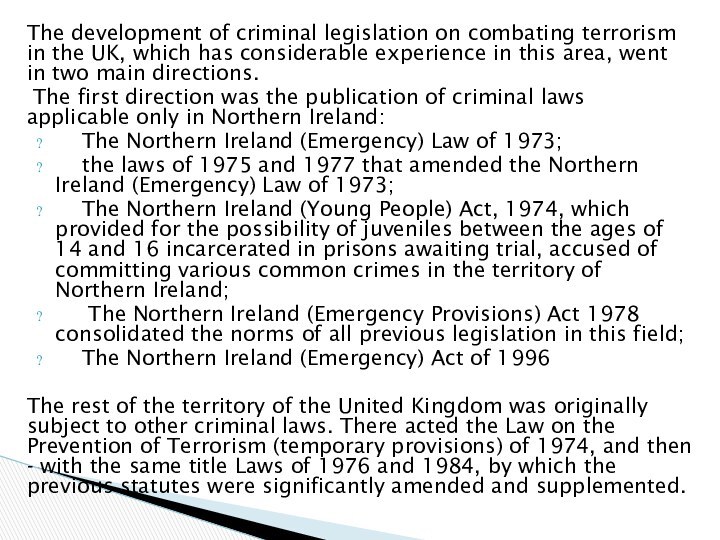
in the UK, which has considerable experience in this
area, went in two main directions.
The first direction was the publication of criminal laws applicable only in Northern Ireland:
The Northern Ireland (Emergency) Law of 1973;
the laws of 1975 and 1977 that amended the Northern Ireland (Emergency) Law of 1973;
The Northern Ireland (Young People) Act, 1974, which provided for the possibility of juveniles between the ages of 14 and 16 incarcerated in prisons awaiting trial, accused of committing various common crimes in the territory of Northern Ireland;
The Northern Ireland (Emergency Provisions) Act 1978 consolidated the norms of all previous legislation in this field;
The Northern Ireland (Emergency) Act of 1996
The rest of the territory of the United Kingdom was originally subject to other criminal laws. There acted the Law on the Prevention of Terrorism (temporary provisions) of 1974, and then - with the same title Laws of 1976 and 1984, by which the previous statutes were significantly amended and supplemented.
Слайд 21
Before the adoption of the Terrorism Act in
2000 (in effect as amended by the Criminal Justice
and Police Act of 2001), the basic laws regulating the practice of criminalizing terrorism were:
The Prevention of Terrorism (temporary Provisions) Act 1989 with additions;
The Northern Ireland (Emergency) Act of 1996;
Law on Criminal Justice (Terrorism and Conspiracy), 1998.
Слайд 22
The English legislator in the procedural field is
ready to go on limiting individual civil rights and
freedoms when it comes to combating terrorism. For example, the Prevention of Terrorism (Provisional Provisions) Act 1989 provided for the broad powers of the police investigating terrorist activities. For example, a policeman could arrest and search without an order any person suspected of involvement in terrorist activities related to Northern Ireland or another territory.
Accession to the European Convention
In 1978, in connection with the accession of the United Kingdom to the European Convention on the Suppression of Terrorism were issued the Law on the Suppression of Terrorism and the Law on Persons Subject to Protection under International Law containing a number of important provisions of a criminal law nature.
Слайд 23
The Law of 2000 stipulates that, its main
provisions will continue to be permanent, although annually the
Minister of Internal Affairs is obliged to report to the Parliament on the course of its application.
With the introduction of new legislation, there is no longer any need to preserve special provisions concerning Northern Ireland. The Northern Ireland (Emergency) Act of 1996 also completely ceased to exist.
In 2000, a new Law on Terrorism was adopted in Great Britain, with which the previous legislation was reformed and significantly supplemented. The Law of 1989 was abolished, but a significant part of its regulations (with a certain modification) entered into the new Law.
Слайд 24
The Law on Counteracting Terrorism, Crime and Security
was adopted in December 2001 following the tragic events
that occurred in New York and Washington on September 11, 2001, in connection with the need for further development of legislation in those areas of life that are particularly in need of additional protection from terrorism.
The 2001 law gave the government new powers in the field of: a) ensuring the possibility of collecting and exchanging information necessary to prevent terrorist acts between ministries; b) modernization of the immigration procedure; c) improving the security system for rail and air transport; e) strengthening of control over toxic substances, which can become the target of terrorist acts or can be used by terrorists.
Counteracting terrorism
Слайд 25
There have been various motives behind terrorism in Great
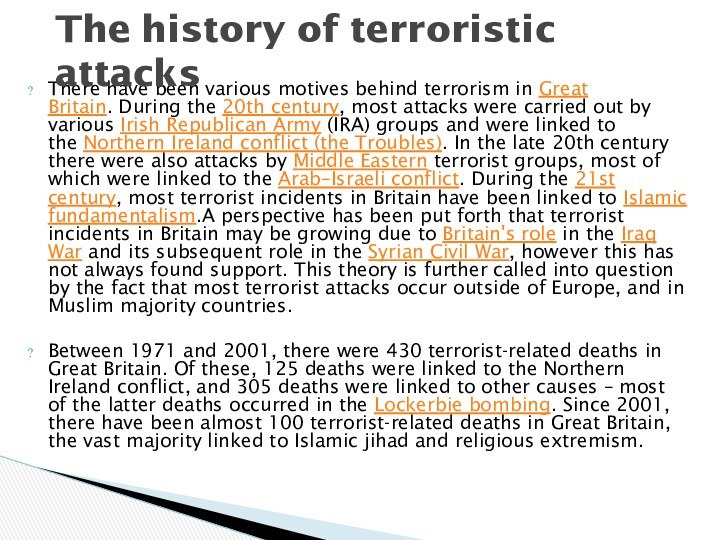
Britain. During the 20th century, most attacks were carried out by
various Irish Republican Army (IRA) groups and were linked to the Northern Ireland conflict (the Troubles). In the late 20th century there were also attacks by Middle Eastern terrorist groups, most of which were linked to the Arab–Israeli conflict. During the 21st century, most terrorist incidents in Britain have been linked to Islamic fundamentalism.A perspective has been put forth that terrorist incidents in Britain may be growing due to Britain's role in the Iraq War and its subsequent role in the Syrian Civil War, however this has not always found support. This theory is further called into question by the fact that most terrorist attacks occur outside of Europe, and in Muslim majority countries.
Between 1971 and 2001, there were 430 terrorist-related deaths in Great Britain. Of these, 125 deaths were linked to the Northern Ireland conflict, and 305 deaths were linked to other causes – most of the latter deaths occurred in the Lockerbie bombing. Since 2001, there have been almost 100 terrorist-related deaths in Great Britain, the vast majority linked to Islamic jihad and religious extremism.
The history of terroristic attacks
Слайд 26
Terrorist incidents map of the United Kingdom 1970-2015.
Northern Ireland and London are major places of incidents.
A total of 4,992 incidents are plotted.
Слайд 27
2017, 22 March: 2017 Westminster attack – Khalid Masood, a
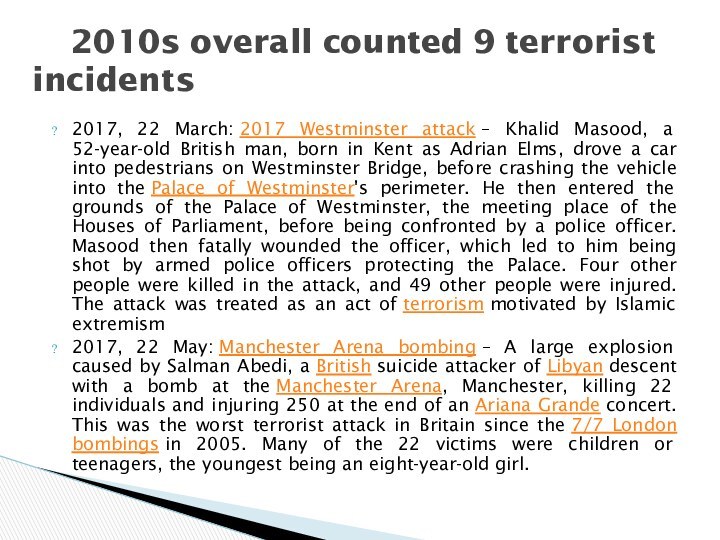
52-year-old British man, born in Kent as Adrian Elms,
drove a car into pedestrians on Westminster Bridge, before crashing the vehicle into the Palace of Westminster's perimeter. He then entered the grounds of the Palace of Westminster, the meeting place of the Houses of Parliament, before being confronted by a police officer. Masood then fatally wounded the officer, which led to him being shot by armed police officers protecting the Palace. Four other people were killed in the attack, and 49 other people were injured. The attack was treated as an act of terrorism motivated by Islamic extremism
2017, 22 May: Manchester Arena bombing – A large explosion caused by Salman Abedi, a British suicide attacker of Libyan descent with a bomb at the Manchester Arena, Manchester, killing 22 individuals and injuring 250 at the end of an Ariana Grande concert. This was the worst terrorist attack in Britain since the 7/7 London bombings in 2005. Many of the 22 victims were children or teenagers, the youngest being an eight-year-old girl.
2010s overall counted 9 terrorist incidents
Слайд 29
2017, 3 June: June 2017 London Bridge attack – Less
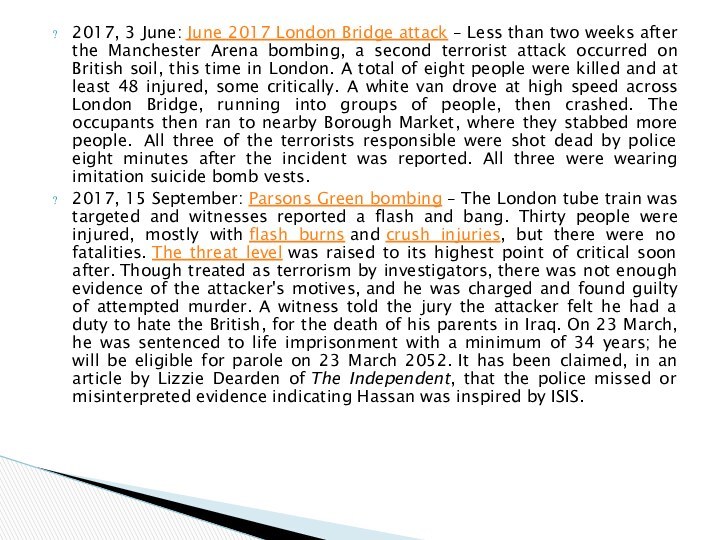
than two weeks after the Manchester Arena bombing, a
second terrorist attack occurred on British soil, this time in London. A total of eight people were killed and at least 48 injured, some critically. A white van drove at high speed across London Bridge, running into groups of people, then crashed. The occupants then ran to nearby Borough Market, where they stabbed more people. All three of the terrorists responsible were shot dead by police eight minutes after the incident was reported. All three were wearing imitation suicide bomb vests.
2017, 15 September: Parsons Green bombing – The London tube train was targeted and witnesses reported a flash and bang. Thirty people were injured, mostly with flash burns and crush injuries, but there were no fatalities. The threat level was raised to its highest point of critical soon after. Though treated as terrorism by investigators, there was not enough evidence of the attacker's motives, and he was charged and found guilty of attempted murder. A witness told the jury the attacker felt he had a duty to hate the British, for the death of his parents in Iraq. On 23 March, he was sentenced to life imprisonment with a minimum of 34 years; he will be eligible for parole on 23 March 2052. It has been claimed, in an article by Lizzie Dearden of The Independent, that the police missed or misinterpreted evidence indicating Hassan was inspired by ISIS.
Слайд 30
Between 2000 and 2017, 126 people have been killed
in the UK in terrorist attacks, according to figures from
the Global Terrorism Database. Although not on British soil, a further 30 British people were killed in Tunisia when a gunman attacked a hotel popular among Western tourists.
This compares to 1,094 deaths in the 15-year period before that, between 1985 and 1999, and a further 2,211 between 1970 and 1984.
The worst year for terrorism-related deaths in the UK was 1988, when 372 people died. The majority of these died in the Lockerbie disaster, when 270 were killed as a Pan Am transatlantic flight was destroyed by a bomb.
Since 1970, Northern Ireland has seen the most terrorism-related deaths out of any nation in the UK, with IRA-related terrorism plaguing the nation for decades.
1972 saw the peak of this violence, with 353 people killed in Northern Ireland - out of a total of 368 in the whole of the UK.
Terror is killing far fewer people in the UK now than it was in the 1980s
Слайд 31
International cooperation in the fight against terrorism
In
the presence of Prime Minister May of the United
Kingdom, President Macron of France and Prime Minister Gentiloni of Italy, leaders from industry, like-minded countries, the UN and EU met today in the margins of the UN General Assembly to reaffirm our collective determination to prevent the Internet from being misused by terrorist groups and individuals. We agreed that terrorist use of the Internet is a global issue that needs innovative, international solutions.
Слайд 32
Joint French-British action plan on Internet security
The 4
agreed priorities include:
improving methods to remove illegal content from
the internet
supporting the efforts of civil society organisations to promote alternative and counter-narratives
working together to ensure our countries can access data for investigative purposes
improving access to digital evidence across borders
Слайд 33
As leaders of the Global Internet Forum to
Counter Terrorism (GIFCT), Facebook, Microsoft, Twitter and YouTube have
emphasized their shared ambition to prevent terrorists from exploiting the Internet to radicalize, recruit and spread propaganda, and to protect their users from terrorists and violent extremists online. They have committed to a range of platform-specific and Forum-wide efforts to better tackle terrorist abuse of open platforms, including exploring artificial intelligence and machine learning to accelerate the identification of terrorist content; building on their hash-sharing database of known terrorist content to help more companies to detect and prevent re-upload of that content; and other initiatives to support smaller companies build capabilities for tackling terrorist abuse of their platforms.
